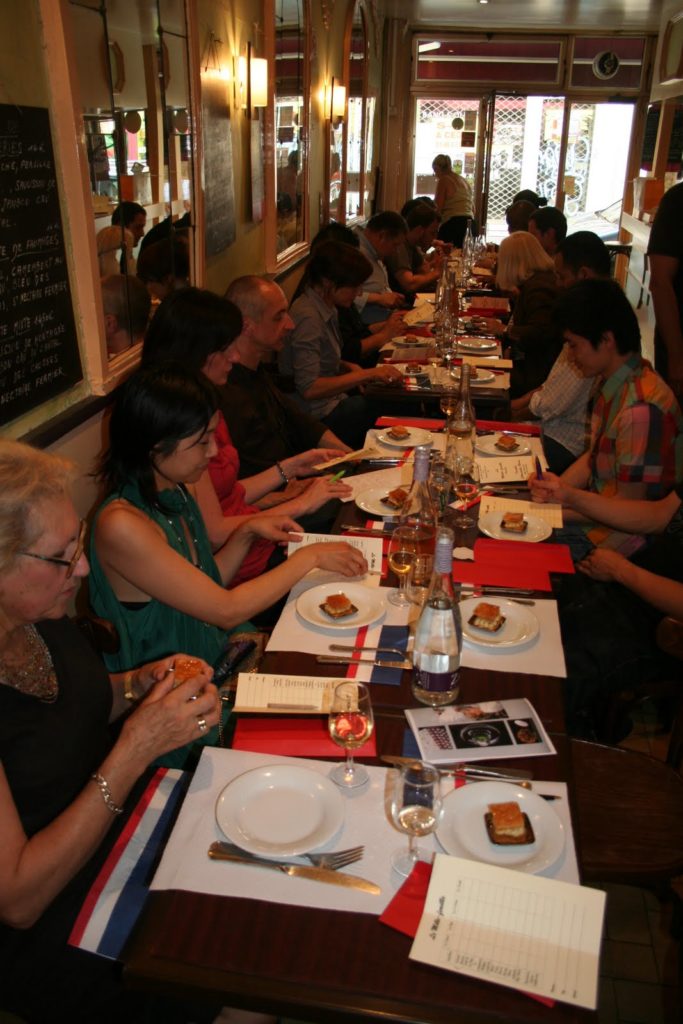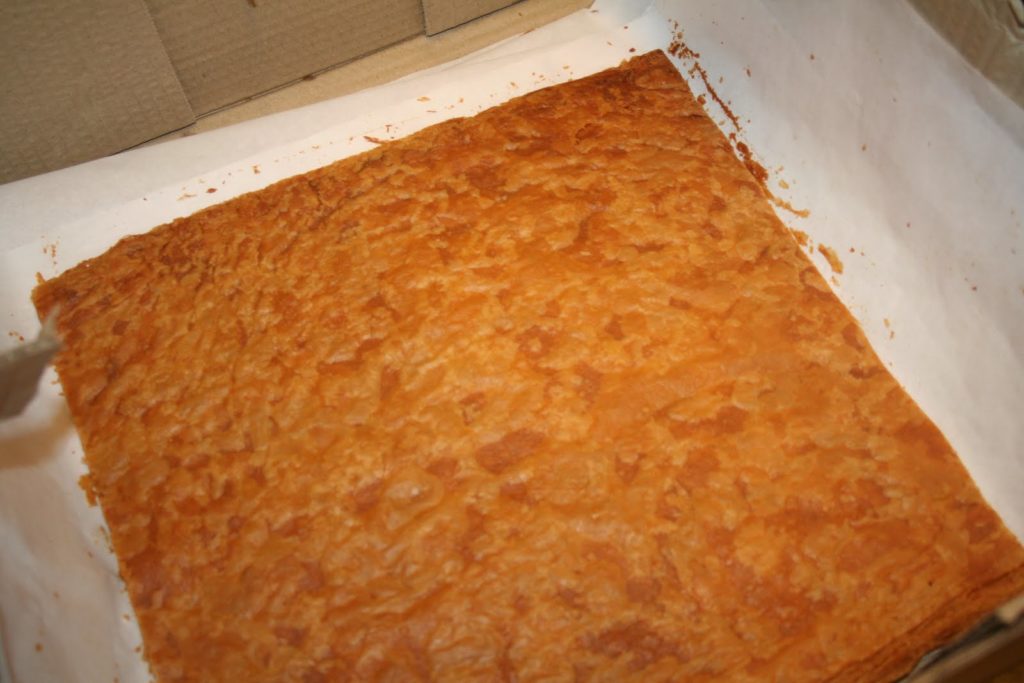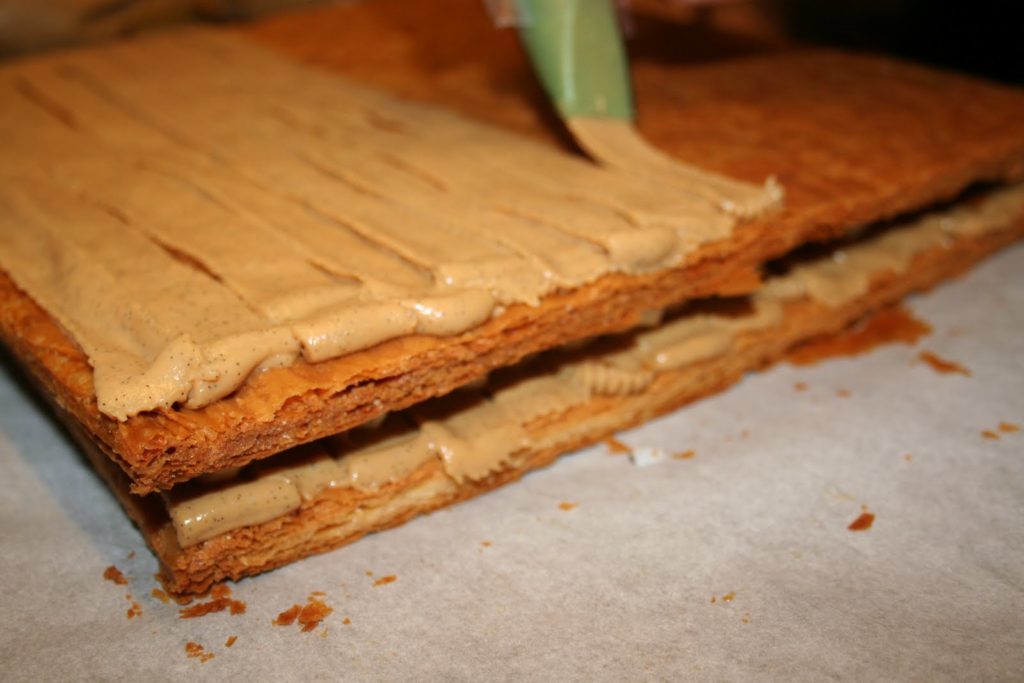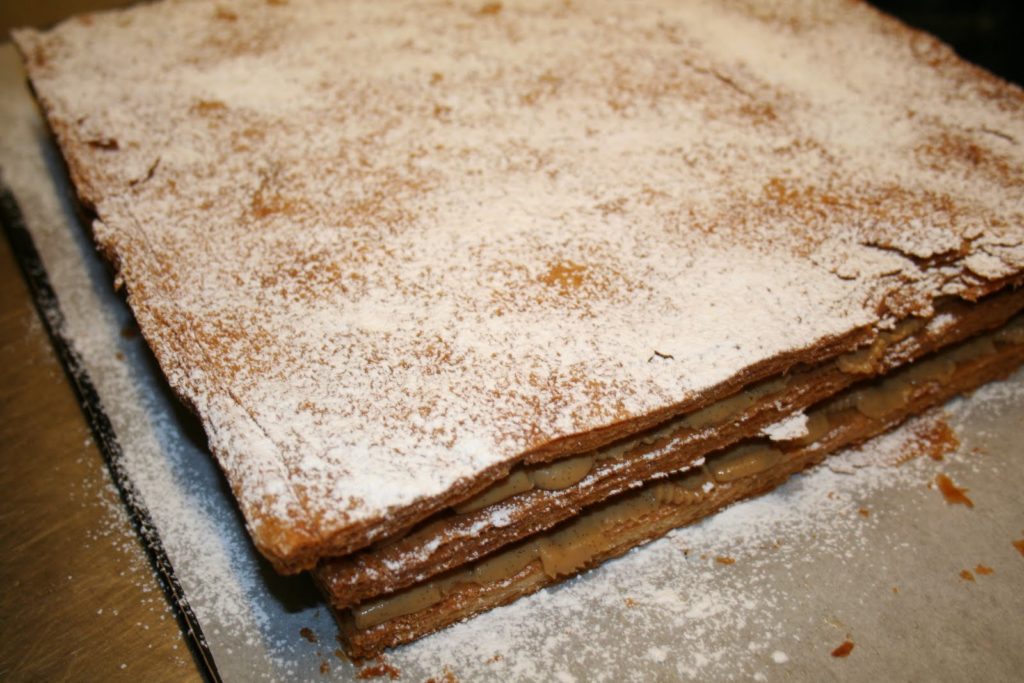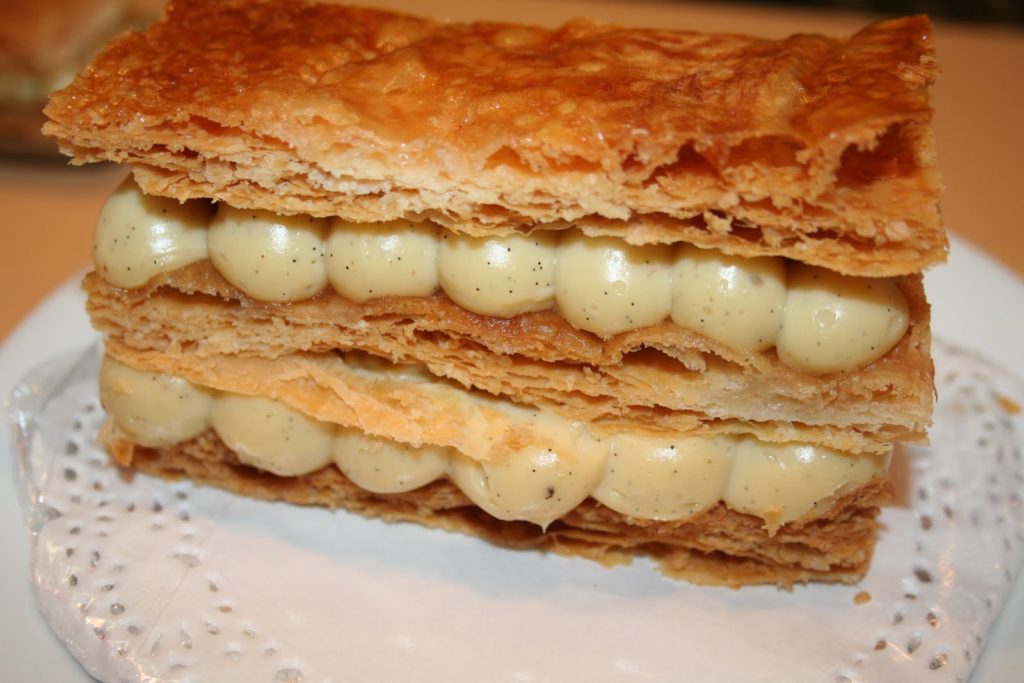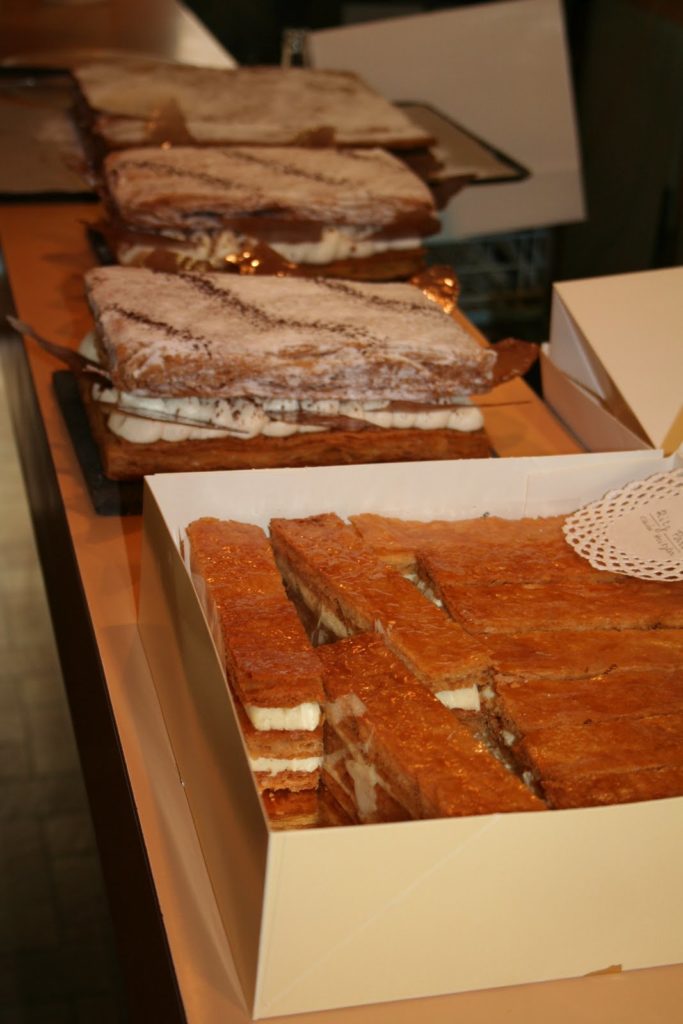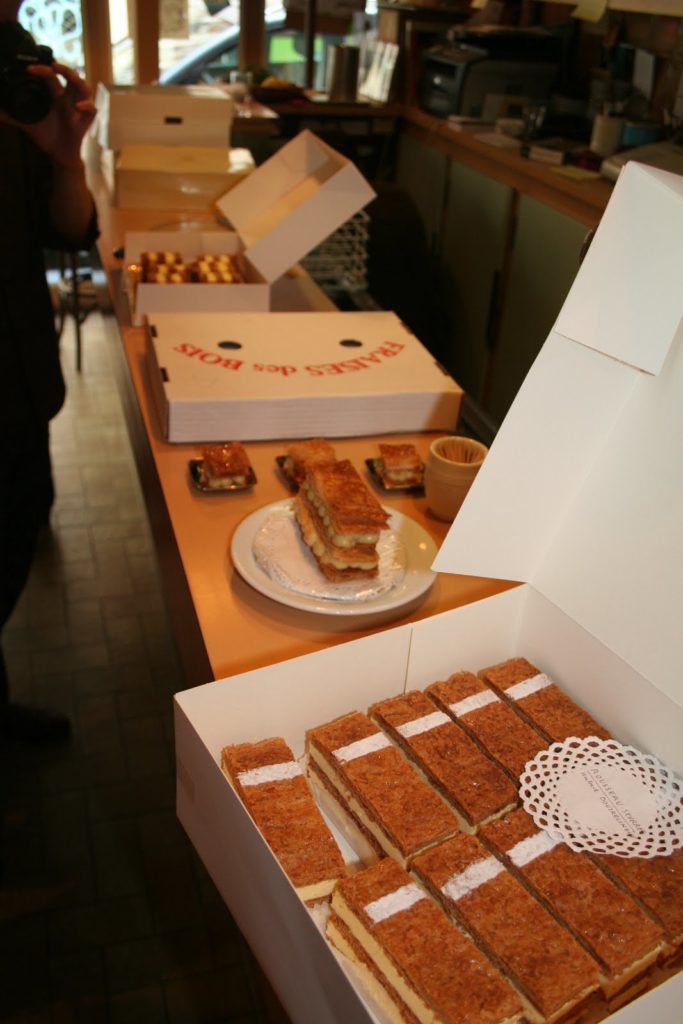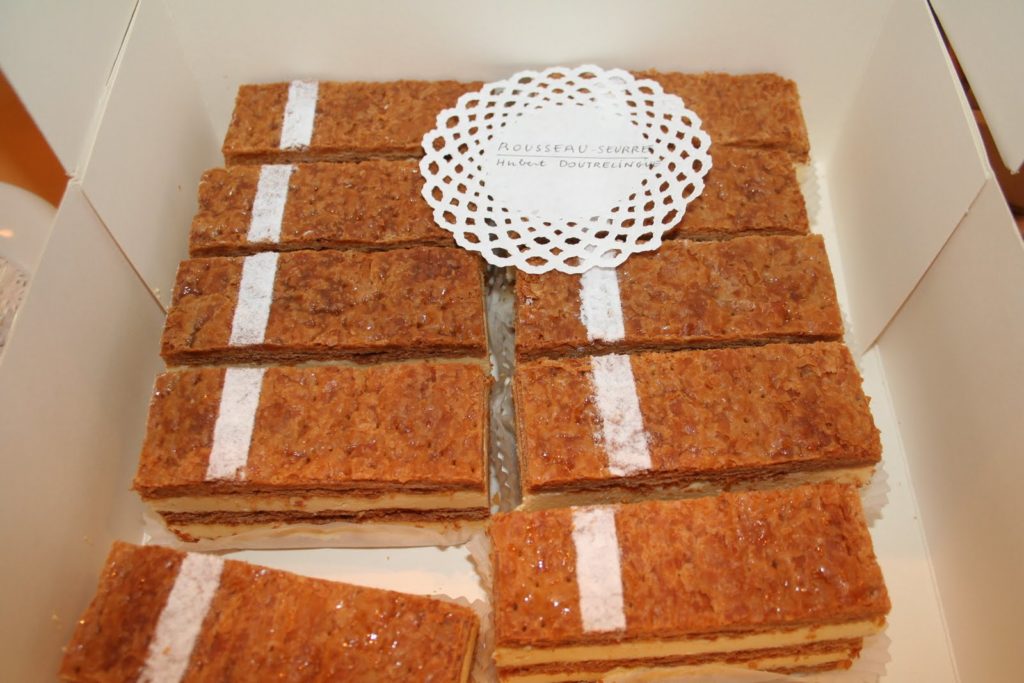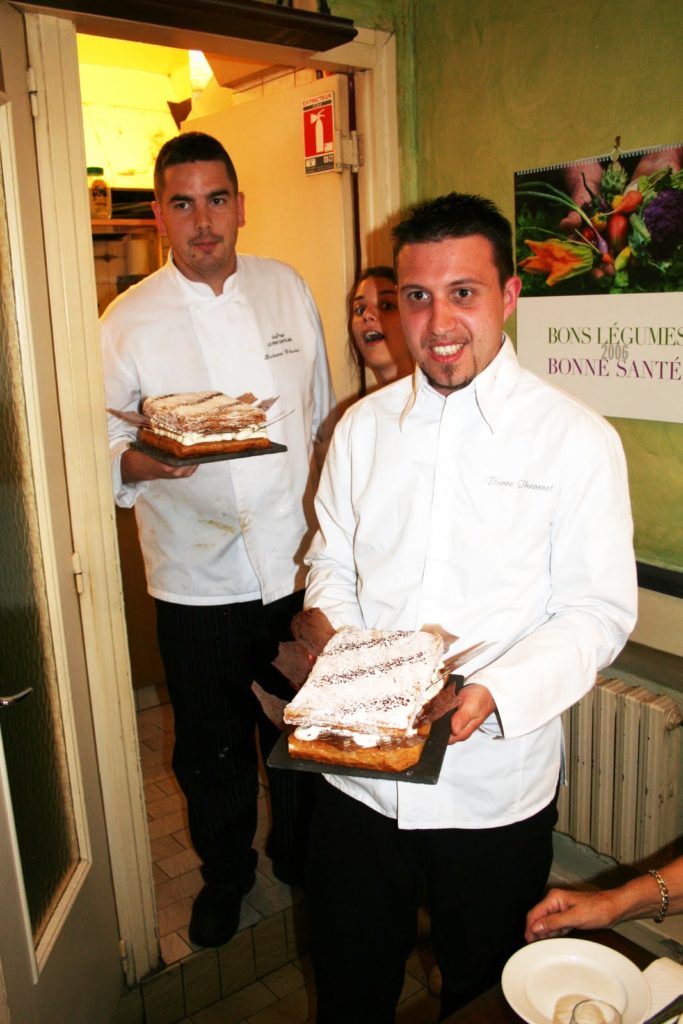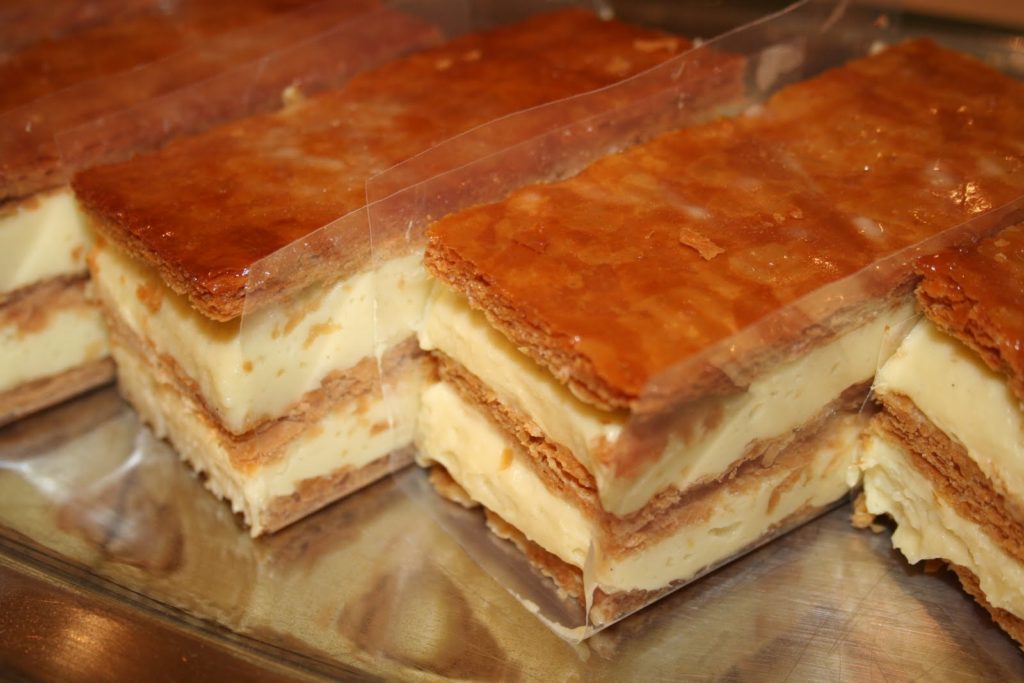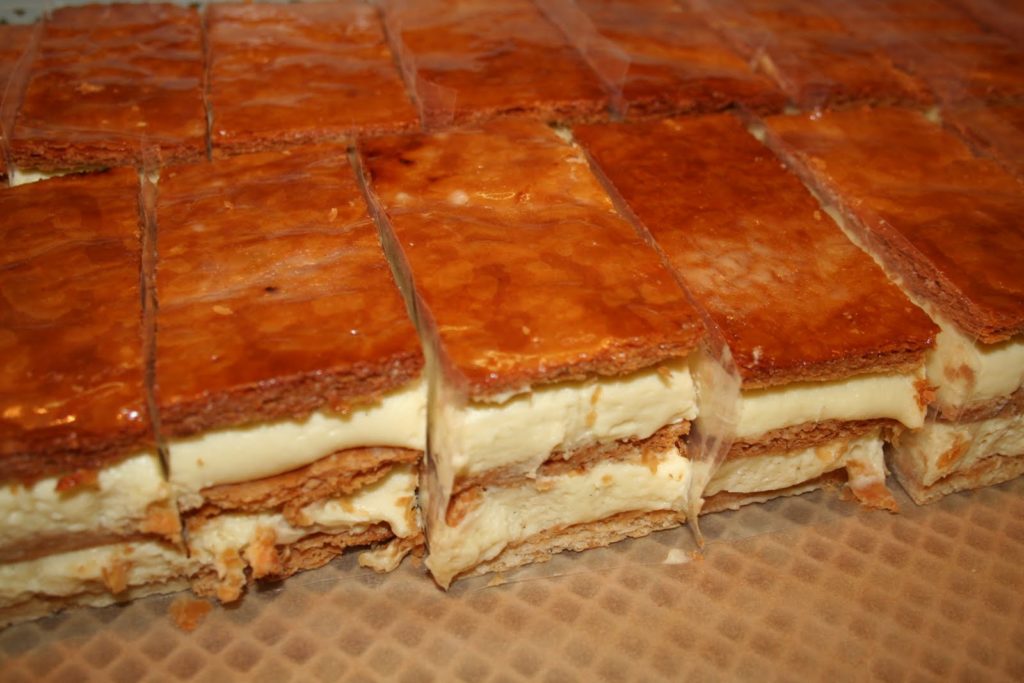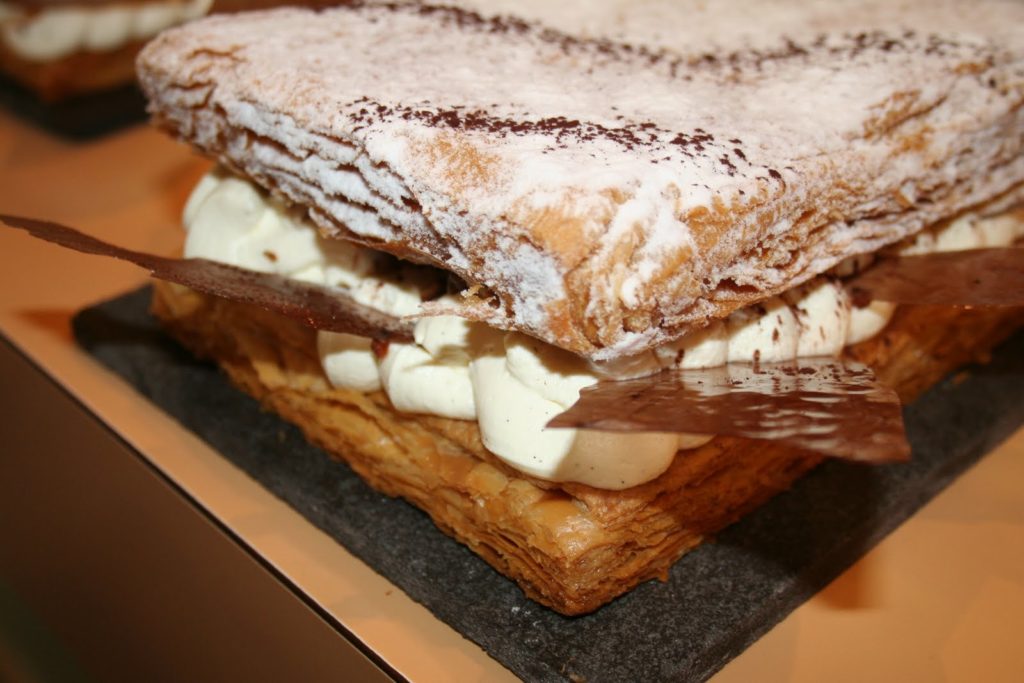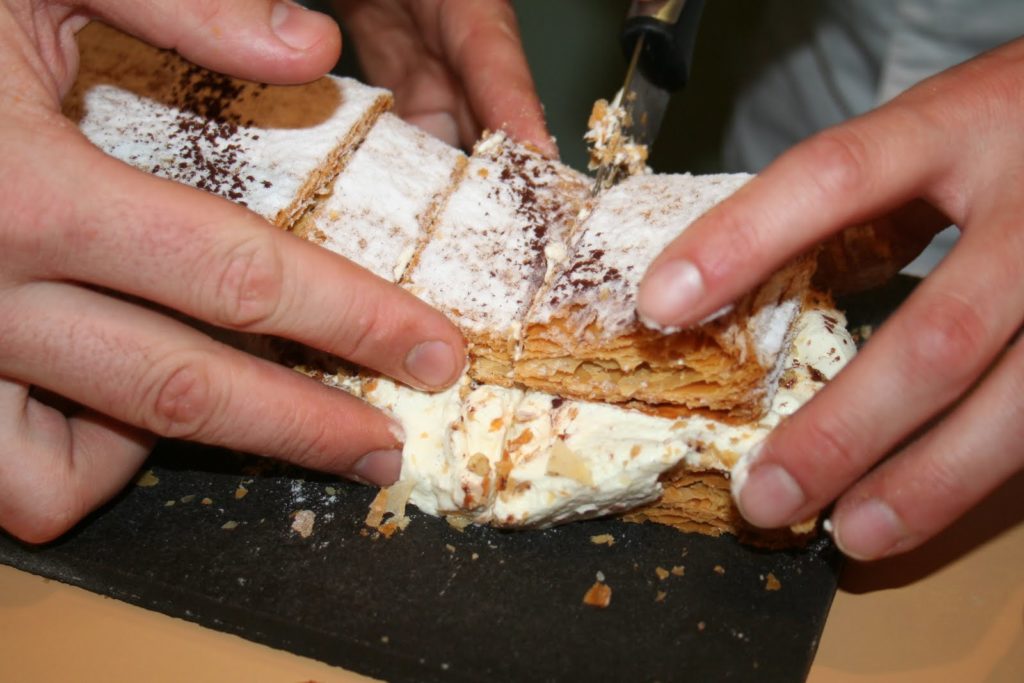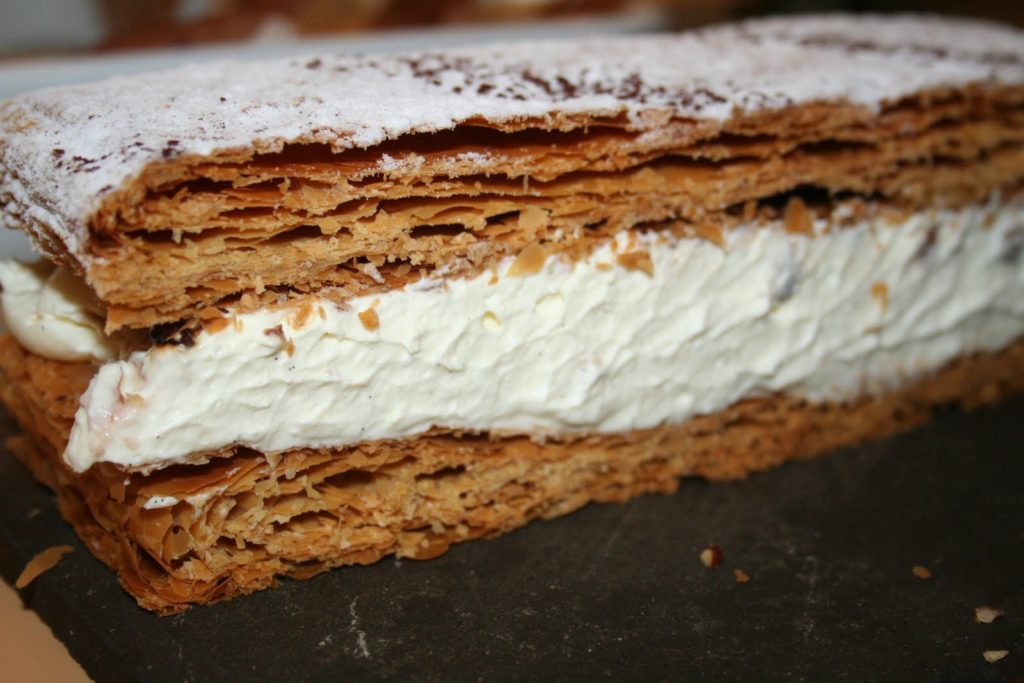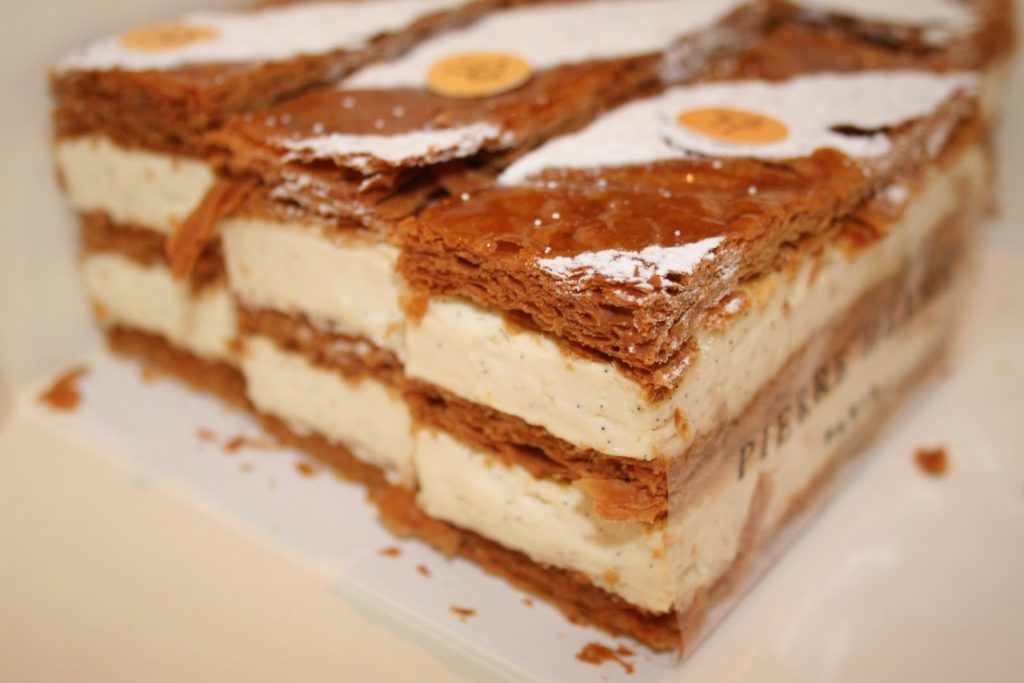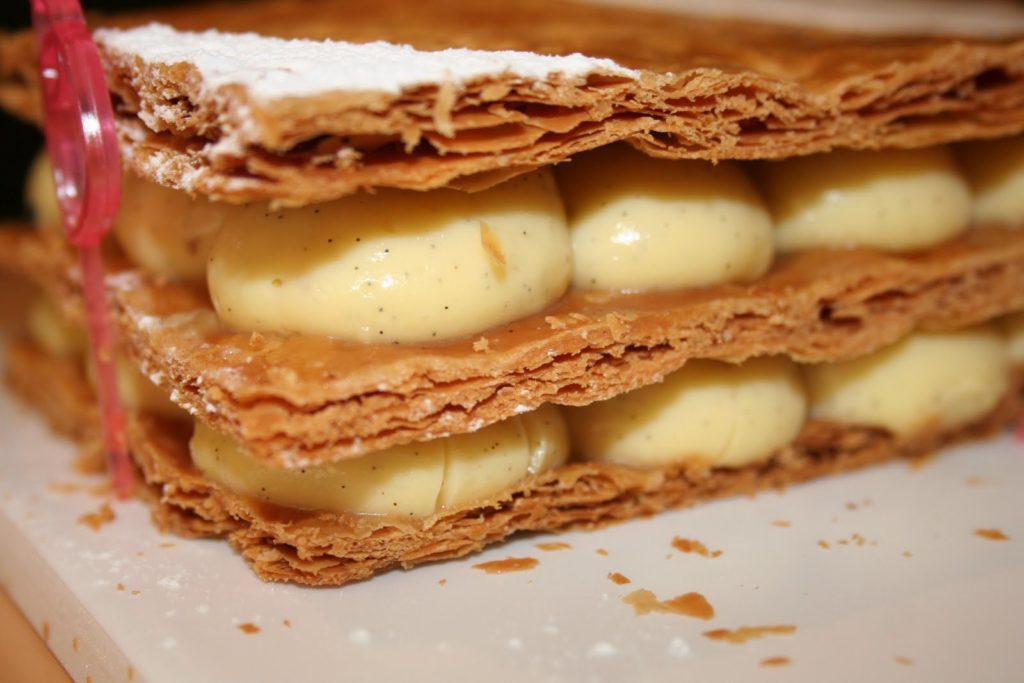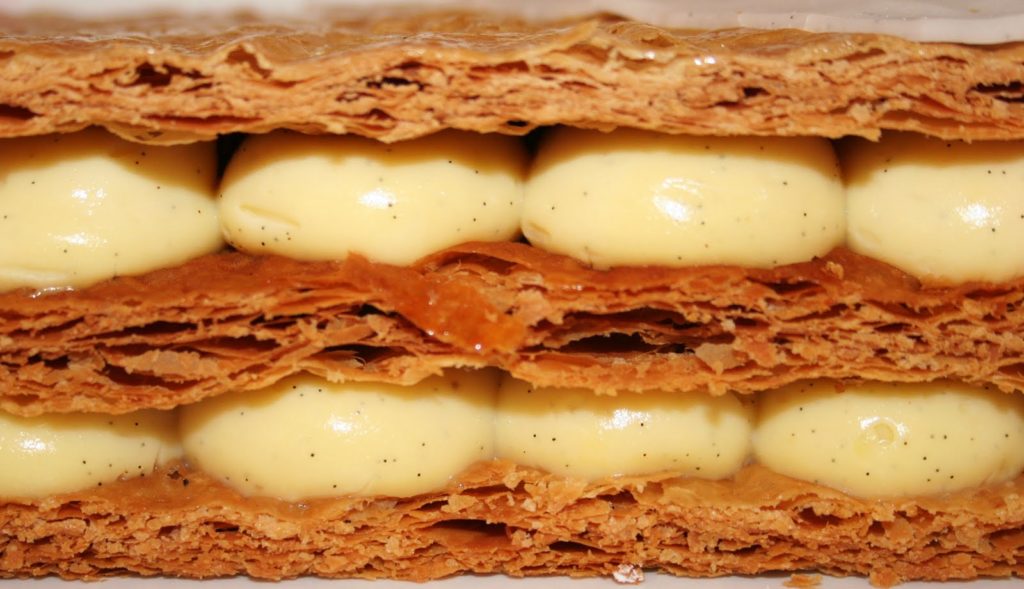474
No, I don’t offer you the recipe (at least not yet!) of the mille-feuilles, but I let you discover the tasting in which I had the immense chance and especially the pleasure to participate. Eleven exceptional mille-feuilles, coming from eleven prestigious Parisian establishments, thirty people to savor them, including the pastry chefs who prepared them, gourmet amateurs and , chocolate makers and a gastronomic historian without forgetting our organizer…
On the program of our afternoon, the following establishments (palaces and boutiques):
Angélina, Rousseau Seurre, Pierre Hermé, Ritz Paris, Plaza Athénée, Taillevent, Café de la Paix, Le Chamarré, Philippe Conticini, Gérard Besson, Le Pré Catelan
“1867: the mille-feuilles of Rouget and/or Sergent:
The word entered the dictionary in 1906… one hundred years after the recipe for mille-feuilles was published by a certain Rouget, about whom nothing is known anymore, and without obtaining the slightest success until the day in 1867 when a man named Sergent (or Seugnot), a Parisian pastry chef established in the lower part of the rue du Bac, proposed it to his customers. It is said that this delicate cake, made of puff pastry with six turns (i.e. six consecutive folds), called by the English -puff pastry- was then sold daily by hundreds.
The traditional mille-feuilles is made up of several layers of thin puff pastry separated by pastry cream. Its surface is covered with white fondant after being apricot-coated and the sides are masked by toasted, blanched almonds. But for a long time the top was decorated with small rings cut out of the puff pastry and baked separately. The mille-feuilles can be small and individual or large to share. But still fresh.”
Excerpt from “La très belle et très exquise histoire des gâteaux et des friandises” by Maquelonne Toussaint-Samat.
“Love should be savored like a delicacy, for love is a delicacy. Near the couch that welcomes lovers, there should always be ice cream, fruit, fine pastries…”
(Curnonsky, La Table et l’amour, 1950)
After this introduction we are all gathered around a big table (there was another one next to it, smaller) at Coude à Coude (a nice little restaurant/wine bar at 46, rue Saint Honoré, 75001Paris) ready to enjoy our mille-feuilles. First one by one, then two by two to better compare textures and flavors.
We all had a little sheet to fill in as we went along to note and compare the different mille-feuilles. I will not talk about that here because it is very difficult to note these mille-feuilles all coming from the “high” pastry shop and moreover I am not a gastronomic critic and all that is free with the appreciation of each one. But yes I admit there were a couple of them that seemed “perfect” to me!
To my question “but why so many mille-feuilles?” our mysterious organizer replied “but what would we do without greed and generosity…?” The tone was set for these three and a half hours of deliciousness!
To ensure the freshness of these mille-feuilles, some of the pastry chefs came with their equipment to assemble the cakes directly in our meeting place!
CHAMARRÉ MONTMARTRE
Let’s start our tasting with this establishment in Montmartre. Our pastry chefs were among those who assembled the mille-feuilles in the kitchen.
Obviously I was there to attend and not to miss anything of the gestures of these professionals!
The tasting being based only on vanilla mille-feuilles (so as not to influence the jury that we were to choose one mille-feuilles rather than another because of our individual preferences, it is easier to compare them on an equal footing!), the Chamarré’s had a thin layer of caramelized and very vanilla milk jam cream before a layer of vanilla pastry cream with whipped cream.
All that was left to do was to cut the edges to obtain a perfect mille-feuilles!
Next, the mille-feuilles of Gérard Besson!
GÉRARD BESSON
Trained at the school of the greatest, Gérard Besson became Meilleur Ouvrier de France at the age of 28 and opened his restaurant in 1978 in the heart of Paris, where he has been cooking noble products with simplicity for more than 25 years.
His awards:
Knight of Agricultural Merit
Officer of the National Order of Merit
Member of the Association of Master Chefs of France
Members of the Culinary Academy of France
Associate Professor for the French Cooking School
Its mille-feuilles in normal individual version…
And in a tasting version. It was finally the smallest part of all the mille-feuilles that would follow. You have to imagine that we ate eleven in a row!
To our historian, we asked for a short history of desserts and mille-feuilles, here is an excerpt of his fascinating speech:
“…Parallel to that develops the art of the pies, we can have flans etc.. that marries what is crust and what is sweetened entremet inside. At the origin it is all that. After the puff pastry such as we know it, it is Parisian of the 17th century, in full of books it is said that it is the painter Poussin who brought it back from Rome, that it is completely false, it is anecdotes and this tradition of the puff pastry comes from the East and from the Arabo-Andalusian cooking, but not in the same way, not by tricks, that is to say that it is the idea of having very thin sheets that are coated with fat that are piled up and when you put them in the oven, they come off instead of sticking. If there is no fat, they stick together, but if there is fat between them, if you brush them with fat, they come off. So this is the case of filo pastry and things like that and this is the example of what we do in Moroccan cooking where sheets of stretched pasta are coated with fat, so all fats are possible, lard, oil etc… that are stacked and when cooked, they do not stick, they come off. So Hervé would explain that they detach because it’s the water vapor that detaches from the dough that creates a space between the sheets and this water vapor must be able to get out and he is said to be unhappy if he doesn’t cut his puff pastry straight at the end, he prevents the layers from sticking together, he prevents the vapor from getting out through the sides. But this idea of making crispy pastry is very very old since it is found in the Arabo-Andalusian cuisine since the 13th century, it is found in the cork cuisine in the 16th century, in the Spanish or Portuguese cuisine in the 17th century but it is not made by tricks. The invention of the Parisian cookery is that instead of taking stretched sheets and brushing them with fat, it is precisely to make the turning. To put the fat between the dough, to fold and to fold again and there we have always the film of fat between two films of dough. And what interests me in the mille-feuilles which is in my opinion a creation of the 19th century, even if there are many premises, it is the meeting of the art of the paste and the crusts and the art of the creams which is at the origin of the sweetened entremets. And that, the history of pastry, is much more difficult than the history of cooking and we could take other cakes like that and we would also find filiations of this type. The story of the pies, for example, is a complicated one. Originally there were fruit tarts, that is something that we find very old in the Middle Ages, but without the fruit, with other preparations, it is later when we found salted tarts. We must always keep in mind that there is sweet because there was salty and that the sweet and the salty have separated. And then the evolution of the pastry profession from making hard crusts in bread dough which were not necessarily eaten, which were given to the dogs, to contain meat and how this work there, following the change of sensibility of the public, we started to put sweetness in these crusts, that’s the idea. Then we started to make crusts that are edible, that are a sweet support, a sweet dessert. It’s hard to pin down, because there are all these subtle passages. There are many legends in the history of pastry and cooking. We must be wary of legends and see historically what we can say and from the documents we have it is very difficult. But that’s what logic is all about, the crust to content ratio. I find it fascinating to take menus from the Middle Ages to the beginning of the 20th century to see how slowly the sweet taste becomes autonomous and migrates at the end of the meal. So we don’t find sugar in the French cuisine anymore, sugar is separated from the salty entremtets. And what do we do with fruits, enriched and sweetened breads, they give the desserts…”
ANGÉLINA
It was my first tasting from this tea room in the rue de Rivoli. I’ve been telling myself for a long time that I have to go there. Well, it’s done and I tasted one of their pastries! And I understand better why this show has such a notoriety!
On the counter of the restaurant, the boxes arrived endlessly and all revealed interiors each more appetizing than the other!
ROUSSEAU SEURRE
Another first for me with this house that I did not know. Pastry chef and caterer in the rue des Martyrs, I’ll be sure to come back to discover their versions of French pastry classics!
RITZ PARIS
We rarely have the opportunity to taste pastries from real Parisian palaces, especially when we know that the price is 19 euros THE share (June 2010)…!
The pastry chefs of the “Pré Catelan” and their works prepared at the minute! It was a constant barrage of pastries.
PEACE CAFÉ
Another institution in front of the Opéra Garnier. I once ate the best chocolate éclair of my life there!
PLAZA ATHENA (Christophe MICHALAK)
Christophe Michalak is the world pastry champion (in 2005) and has been the pastry chef at the Plaza Athénée (3 Michelin stars) since 2000 after working at Fauchon, Ladurée and Pierre Hermé in New York!
TAILLEVENT
LE PRÉ CATELAN (Christelle BRUA)
Christelle BRUA, pastry chef of the three-star restaurant Pré Catelan, quickly climbed the steps of the sweet podium, crowned by the trophy of the Pastry Chef of the Year 2009!
Not easy to cut a mille-feuilles! You have to work together. The problem of our appointment was that it was very hot (30 degrees on this day of June 29, 2010!) and that the creams, as soon as they came out of the refrigerator began to soften, making the cakes sometimes unstable and perilous to slice!
PIERRE HERMÉ
Pierre Hermé no longer needs to be introduced, as he has undoubtedly become one of the best known chefs in the world!
PHILIPPE CONTICINI
Working at La pâtisserie des rêves, Philippe Conticini has worked in prestigious restaurants. Pastry chef for thirteen years at the Table d’Anvers, he then took over the management of the Petrossian, until 2003. That same year, he won the World Pastry Championship with the French team he was leading. At the helm of the Pelletier pastry shops in New York and Tokyo, he easily exports his talent.
As you can see, all these mille-feuilles are beautiful to look at and show a great technical mastery that will not fail to inspire us to do better! But we can also say that we can jump into this recipe without fear because there is not one that transcends the other while their fillings are often quite different! Pastry cream, pastry cream AND whipped cream, pastry cream and butter cream, chiboust cream…. all variations are possible. The difficulty comes mainly from the puff pastry. Classic for some, inverted for others, inverted caramelized…. It is up to each of us to compose the mille-feuilles of our dreams. I now have my own ideas on the subject and I will be sure to take inspiration from these great chefs and their vivid imagination!
If you want to see a different point of view of this meeting, go to the site of Yoko (click
here
!!). It’s in Japanese but there are pictures of mille-feuilles!
here
!!). It’s in Japanese but there are pictures of mille-feuilles!
In the meantime, if you want to make a delicious folly and try one of these mille-feuilles here are the addresses of the establishments mentioned:
Pierre HERMÉ:
72, rue Bonaparte 75006 Paris
85, rue de Vaugirard 75015 Paris
Hotel PLAZA ATHENS
25, avenue Montaigne 75008 Paris
ROUSSEAU SEURRE
22, rue des Martyrs 75009 Paris
RITZ PARIS
15, place Vendôme 75001 Paris
GÉRARD BESSON
5, rue Coq-Héron 75001 Paris
CHAMARRÉ MONTMARTRE
52, rue Lamarck 75018 Paris
TAILLEVENT
15, rue Lamennais 75008 Paris
LE PRÉ CATELAN
Bois de Boulogne, Route de Suresnes 75016 Paris
PEACE CAFÉ
12, boulevard des Capucines 75009 Paris
ANGÉLINA
226, rue de Rivoli Paris
THE PATISSERIE OF DREAMS
93, rue du Bac 75007 Paris

